Controlling Costs in the UK Construction Industry
| ✅ Paper Type: Free Essay | ✅ Subject: Construction |
| ✅ Wordcount: 4104 words | ✅ Published: 23 Sep 2019 |
1.0 Introduction
1.1 Research Title
Controlling Cost in UK Construction Industry – A case study of Edinburgh Tram Project.
1.2 Background
The construction industry is known globally to be very complex, project based and cost intensive with massive input in various country’s economy. The UK Construction industry constitute about 7% of the UK economy, contributing about £92billion gross value to the UK economy annually (DBIS 2013; Smith 2014).
Delivering completed and functional facilities within the budgeted cost, approved timeframe, quality and standards is the main aim of every construction project (Olawale and Sun 2015). Nevertheless, it has been difficult to deliver most construction projects within the budgeted cost and time over the years despite many research works in construction cost control and the availability of many cost control tools and techniques (HM Government 2013; Azis et al 2012). To understand how cost can be controlled in construction projects, cost control need to be defined and explained.
According to Karzner (2009) and PMI (2013) Control Costs is defined as a subsystem of cost management which consists of cost estimation, monitoring project cost status in line with changes to the scope against the approved project cost with the aim of ensuring completion of the project within the budgeted cost.
The Edinburgh Tram project is the 3rd largest construction project in Scotland with the intension of making Scottish transportation faster and safer, reducing traffic congestion in Edinburgh City, while providing transportation access the Scottish local economies. It is a mega project which started in 2006 and consist of construction works that links the Edinburgh Airport to the City centre. The initial project cost that was awarded to the 5 major contractor (Transdev, Parsons Brinkerhoff, Construcciones Auxiliary de Ferrocarriles SA (CAF ), BBS, and Alfred McAlpine Infrastructure Services (Now- Carillion) in January 2006 is £569million. This initial cost was later revised to £592million in November 2006. The project was delivered in May 2014 with final project cost of £776 million. (City of Edinburgh Council 2014; Railnews 2012; Boateng 2015; Audit Scotland 2011).
The Initial project governance board is captured in Figure 1.1 below:
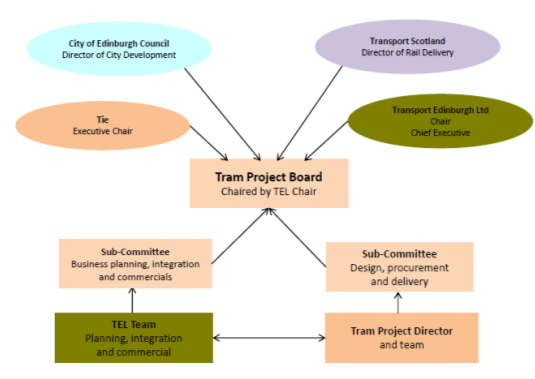
Figure 1.1: Edinburgh Trams Governance Structure (Audit Scotland 2011)
This research will evaluate ways of controlling construction cost in the UK Construction industry. In addition, it will also review the Edinburgh Tram project in order to understand cost control issues, tools employed and how they were resolved.
1.3 Research Rationale
There both academic and personal rationales for this research as explained below:
Academic Rationale: Over the years, cost control and cost overruns in construction projects have been discussed, researched and recommendations outlined. These studies and publications on the subject matter is continuously increasing the academic resources in the knowledge area. However, after these existing research works on the cost control in construction, most construction projects still experience cost overruns. Hence the need for further research on the subject matter using a live project. Upon completion of this research, an additional literature on construction cost control will be published and it will the researcher to complete some of the requirement for the award of Bachelor of Science in Management.
Personal rationale: Following my brief experience in the construction industry in Africa – where about 75% of projects in the industry experience delays due cost overrun and other cost management issues. These continuous cost related encountered in the construction industry has motivated me to evaluate and investigate cost control processes and techniques in the UK (Another Country) using a mega project – The Edinburgh Tram Project.
1.4 Research Aim
The aim of this research is to evaluate ways of controlling construction cost in the UK, by critically evaluating the Edinburgh Tram project.
1.5 Research Objectives
- To understand how construction cost can be managed.
- To identify current cost control tools and techniques in UK construction projects.
- To critically evaluate the Edinburgh Tram project
- To ascertain cost related issues that affected the Edinburgh Tram project.
- To outline and review cost control issues in UK construction projects.
1.6 Assumptions, Considerations and Constraints
1.6.1 Assumptions
- It would be assumed that the budgeted funds are available for the research.
- All the identified respondents (research participants) would agree to participate.
- Supervisor would be readily available to meet the researcher and give feedbacks.
- The research topic is very relevant in the Construction industry
- There would be enough publications and literatures required for the research.
1.6.2 Considerations
The research considerations are as follows:
- The sources of literatures for review will be considered
- Availability of the funds captured in the research budget to fund the research.
- The research approach, Methods, data collection and analysis routes will be considered.
- All ethical issues involving business research would be considered
- The handiness of the right literatures required for the successful completion of the research.
1.6.3 Constraints
The constraints include:
- Time – time required to carry out the entire research.
- Unavailability of all the resources such as funds required for the research
- Inability to contact the supervisor
- Reluctance to participate in the research by the respondents.
2.0 Initial Literature Review
Literature review is a critical part of every research, as it evaluates current knowledge and reveals gaps within the research study areas (Ridley 2012). Initial literature review for this research will briefly review articles in the UK Construction Industry, Costs control and the Edinburgh Tram Project as follows:
2.1 The UK Construction Industry
The Construction industry in the UK contributes greatly to the UK economy. In fact, it is one of the critical sectors of the economy as it constitute about 7% of the UK economy, contributing about £92billion gross value to the UK economy annually (DBIS 2013; Smith 2014). Currently, the industry is made up of about 2,800 businesses and employs about 3million people (HM Government 2017).
Business activities in the construction industry include: civil engineering works, Building roads, houses and bridges, repairs, maintenance and refurbishment of houses and infrastructure works (Hussin et al 2013; Szymanski 2008). The Major stakeholders in the UK construction Industry include: UK Government, Contractors/ Consultants – (Architects, Quantity Surveyors, Builders, Civil Engineers) Suppliers, The public, Press. Employees etc.
In spite of the skilled and experienced stakeholders, alongside the positive contribution of the industry’s activities to the UK economy, the UKCI is still struggling with problems such as project delivery delays, cost overruns, and lack of skilled labour (Agapiou et al 1995). In order to understand the root cause of the above listed issues beleaguering the UKCI, most literatures were reviewed and causes such as frequent Scope changes, trust issues, highly fragmental construction supply chain, poor communication, old-fashioned procurement route and poor cost estimations and other causes were outlined as some of the causes of cost and schedule overrun issues in the UKCI (Jackson 2002; Olawale and Sun 2010; Proverbs et al 2000).
2.2 Cost Control
Controlling cost is very critical for any business/project to succeed, because lack adequate cost control in project may lead to project/business failure as a result of Cost overrun (Bahaudin et al 2012). In the UK cost control in construction projects have well researched and published by authors such as Olawale and Sun 2010; Jackson 2002; Proverb et al 200; Pryke 2009, Egan 1998; Latham 1994 and others.
Despite the many research on construction cost control in UK construction, most projects still overrun their budgeted cost. Although these research publications has helped most construction firms control their cost better when compared the rate of cost overrun with other countries (For example, the average rate of cost overrun in the UK is about 10%, Slovenia is 51% and Nigeria is about 14%) (Omoregie and Radford 2006; Olawale and Sun 2015; Nikic 1998). Furthermore Flyvbjerg et al in 2003 carried out a worldwide research on construction cost control. They critically reviewed 258 global construction/infrastructure projects amounting to US$90billion and discovered that 9/10 of global construction projects had cost overrun issues at an average rate of about 28%.
Furthermore, notable cost control tool have be used over the years to control cost in construction projects. Tools like Earned Value Management, Whole life costing, Asta projects, Primavera, Microsoft Projects, Costing, Cost Breakdown Structure and others have been used in projects with the aim of managing construction effectively on the other hand, despite the regular use of these tools, construction projects still overrun their budgeted cost (Olawale and Sun 2015; Azis et al 2012). Some of the reviewed publications believe that the widely used cost control processes and tools in construction were designed to be reactive, because they are good in finding and measuring cost variances and deviations from the budgeted project cost instead of preventing the variations (Bahaudin et al 2012). Other researchers from some reviewed literatures are of the opinion that gaps such as poor cost estimations, frequent scope changes, ineffective risk management practices, highly fragmented construction supply chain, fluctuation of construction material prices and others were the reasons behind the inability construction firms to effectively manage and control their project cost (Memon and Azis 2012; Olawale and Sun 2010; Pryke 2009; Smith et al 2014).
2.3 Edinburgh Tram Project
The Edinburgh Tram project is the 3rd largest construction project in Scotland with the intension of making Scottish transportation faster and safer, reducing traffic congestion in Edinburgh City, while providing transportation access the Scottish local economies. It is a mega project which started in 2006 and consist of construction works that links the Edinburgh Airport to the City centre. The initial project cost that was awarded to the 5 major contractor (Transdev, Parsons Brinkerhoff, Construcciones Auxiliary de Ferrocarriles SA (CAF ), BBS, and Alfred McAlpine Infrastructure Services (Now- Carillion) in January 2006 is £569million. This initial cost was later revised to £592million in November 2006. The project was delivered in May 2014 with final project cost of £776 million. (City of Edinburgh Council 2014; Railnews 2012; Boateng 2015; Audit Scotland 2011).
The project design/ map is show in the figure below:
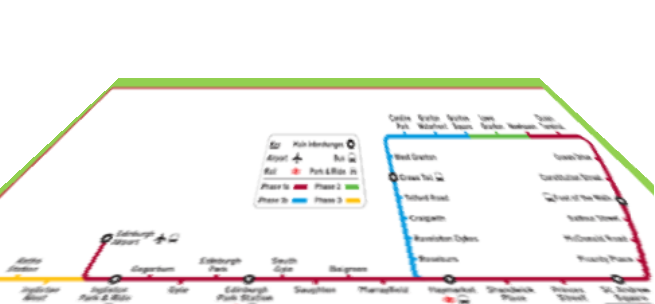
Map of the Edinburgh Tram project
According to Lowe (2010), the project was executed using turnkey contracts by both City of Edinburgh Council (CEC) – Project owner and Transport initiative Edinburgh. Other strategies employed during project execution which lasted 8 years are the inclusion of both suppliers and contractors in the design phase of the project, adoption of fixed priced contracts and others (Boateng 2015; Lowe 2010).
Despite the use of BS EN ISO 9001 to ensure quality of the project, the Edinburgh tram still experienced cost overruns, as the project was delivered with the total cost £776 million against the revised budgeted cost of £592million (Boateng 2015; Rail News 2012; Lowe 2010).
3.0 Research Methodology
According to Sekaran and Bougie (2010), Research methodology is critical to any business research; as it shows the orderly patterns of planning for, studying, analysing and solving the research problems. It also outlines the steps, approaches and methods that will be taken by the researcher while carrying out a research in order to achieve the objectives of the research (Kothari 2004).
In this proposal, the research adopted approach, Methods, Data collection and analysis methodology will be reviewed.
3.1 Research Approach
The research onion which will be used in details in Chapter three shows that business research can take two approaches: a) Inductive reasoning and b). Deductive reasoning (Saunders et al, 2009). Deductive approach are mostly used in quantitative research as it allows the researcher to develop hypothesis using existing theories and literature on the subject. These hypotheses are tested afterwards by the researcher using scientific systems (Saunders et al 2009).
On the other hand, the inductive research approach allows the researcher to observe explicit research variables through surveys and existing literatures, after which the researcher draws conclusions and may lead to invention of new theories in the knowledge area (Saunders et al 2009; Sekaran and Bougie 2010).
For this research, inductive research approach will be used as it works well with case study research. This approach will afford the researcher the opportunity to understand the concept of cost control and its application and practices in the UK construction industry. The Inductive approach will also help the researcher to extensively review the Edinburgh Tram project in order to understand cost control techniques applied and also reveal cost control gaps in the project and in the UK Construction Industry as a whole. Therefore helping the researcher to develop models and theories on cost management and control in the UKCI.
3.2 Secondary Research
For this research, secondary data from peer reviewed journals, technical papers, academic books would be used to compliment primary data collected from interviews, group sessions and case study as means of validating and comparing the results from the primary data (Saunders 2009; Davison, et al 2007).
3.3 Primary Research (Data collection)
This phase of research shows how the primary data required for the successful completion of the research will be collected. The various data collection means in business research include: Observation, Questionnaires, Focus group, interviews and Case Study. However, a pilot study will be carried out by researcher using 6 construction professionals (Supervisors, engineers, Quantity surveyors, Project Managers and fellow students) before the main primary data collection in order to determine the suitability of the research questions.
For this research, Interviews, Focus group sessions and Case Study would be used for primary data collection as reviewed below:
3.3.1 Interviews
The researcher will interview experienced 15 construction professional with about 10-15 years’ experience in the UK construction industry. The interviews give the researcher an insight into cost control practices in the UK construction industry (Kothari 2004). 5 out of 15 people that would be interviewed must be professionals who worked in the Edinburgh Tram project.
Some of the professionals to be interviewed include: Procurement managers, project managers, Project Engineers, Quantity surveyors and contractors. The interview questions will be sent to the professionals a week before the interview to enable them prepare for the interview.
3.3.2 Focus Group Session
In this phase of data collection, a group comprising of 14 experienced construction professional in the UK construction industry. 10 out of the 14 professionals should be from the Edinburgh tram project, while the remaining 4 should be outside the tram project. The session will last for about 4 hours and will focus on reviewing
3.3.3 Case Study
After reviewing the data obtained from focus group and interviews, Case study will also be use by the research to closely evaluate the tram project. In order to successfully obtain credible data, will visit the project office regularly and have in-depth discussions with the project stakeholders.
Since an inductive approach will be used for the research will, the researcher would use the case study to evaluate the efficacy of proposed cost control methods in the UK construction industry.
3.4 Data Analysis
According to Cohen et al (2007) analysis of research data involves the use of cogent and mathematical methods in order to convert the collected raw data into research results and verifiable facts. This process will either lead to evolution of new hypothesis or authentication of existing theories (Kothari 2004). Cohen et al (Saunders 2009) suggests that business research data can be analysed qualitatively or quantitatively.
For this research, all data would be collected qualitative using Focus Group Sessions, interviews and Case Study. These data would also be analysed qualitatively using software such as the NVivo™ data analysis tool.
4.0 Research Work Plan
The dissertation schedule below shows that it will take the researcher 119days to successfully complete the research. The research work starts on Monday October 15, 2018 and ends on Friday March 29, 2019.
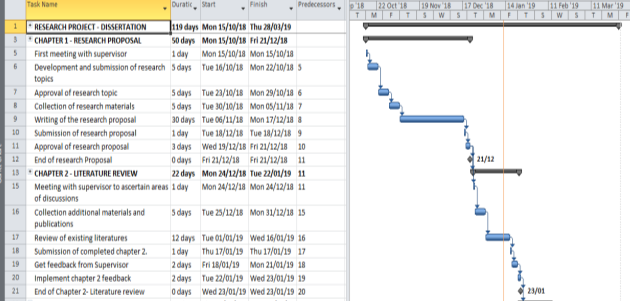
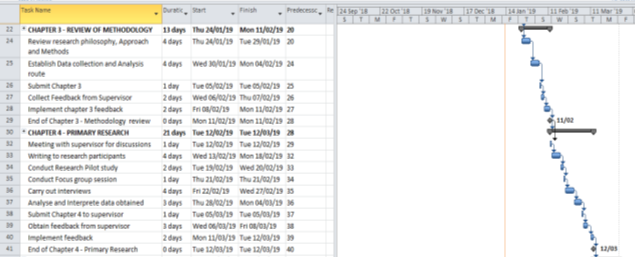

Research plan for the dissertation
5.0 Research Requirements
The cost of all the required resources for the execution of this academic research within a period of 4 months is broken down in the table below:
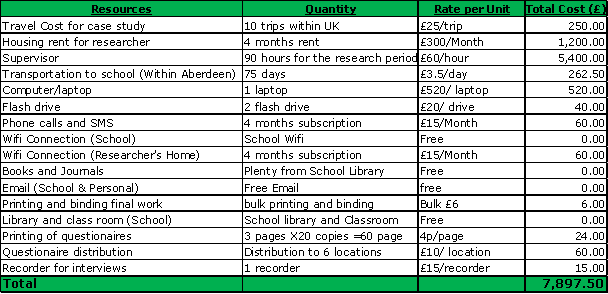
From the table above, the sum of £7,897.50 will be required to complete the research.
6.0 Research Risk Management Plan
Every research or project has risks associated with them (Prince 2 2009). According to Saunders et al (2009), Risk Management Plan for a research is a live document developed by researcher which help them identify, plan and mitigate all likely risks that may affect outcome the research.
For this research, a risk Management plan will be developed to help the researcher to identify, rate and mitigate any likely risk that may affect the research outcome.
The table below shows the risk management plan for this research. In the plan, the formula: Risk = Likelihood X Impact was used.
Where:
Likelihood (L) = Probability of risk occurring
Impact (I) = measure of risk if it occurs.
The rating of Likelihood and impact for risk are described below:
|
Risk Rating |
Likelihood |
Impact |
|
1 |
Very Unlikely |
Negligible effect |
|
2 |
Unlikely |
Minor effect |
|
3 |
Likely |
Judicious impact |
|
4 |
Very likely |
Major impact |
|
5 |
Definite |
Disastrous effect |
|
Likelihood of risk occurring |
Impact of risk |
||||
|
Negligible effect 1 |
Minor Effect 2 |
Judicious impact 3 |
major impact 4 |
Disastrous Impact 5 |
|
|
Definite – 5 |
5 |
10 |
15 |
20 |
25 |
|
very likely – 4 |
4 |
8 |
12 |
16 |
20 |
|
Likely – 3 |
3 |
6 |
9 |
12 |
15 |
|
Unlikely – 2 |
2 |
4 |
6 |
8 |
10 |
|
very unlikely – 1 |
1 |
2 |
3 |
4 |
5 |
|
Identified risks |
I |
L |
Rating of risk (IXL) |
Response/Mitigation |
Residual Rating |
|
Respondents and corporate bodies not willing to participate in research. |
4 |
3 |
12 |
Many respondents (10 more than the required number) would be formally notified during the planning phase of the research. This will help the researcher secure the required respondents for the research. |
4 |
|
Lack of experience in data collection and Analysis |
4 |
4 |
16 |
The researcher would attend all research training and preparatory lectures and will always consult with the supervisor for clarifications and advice. |
8 |
|
Unavailability of supervisors for feedbacks |
4 |
2 |
8 |
Researcher will be always in contact with the supervisor via RGU mail or SMS. Also, Both will agree and adhere with the research timelines. |
4 |
|
Use of unacceptable publications and articles required for the research. |
3 |
3 |
9 |
Only acceptable peer reviewed articles and publications would be used. Also, the researcher would consult the supervisor to review and approve all publications intended for the research. |
3 |
|
Poor time management leading to not meeting the research deadlines |
4 |
4 |
16 |
The project plan would strictly followed by the researcher. In addition, in case of any expected delay, the researcher would inform the supervisor early enough. |
8 |
|
The use of wrong data collection and analysis approach. (wrong research approach and methods) |
5 |
3 |
15 |
The research would attend all research training and preparatory lectures in order to understand and evaluate the existing research methods. This will enable the researcher to select the right method for the research. Also, research methods for related journals would be reviewed by the researcher. |
5 |
|
Lack of fund required to successfully complete the research |
5 |
3 |
15 |
The researcher will ensure that all the required funds are available before the research start. |
5 |
|
Loss of research documents such as literatures and data due to technical issues. |
4 |
4 |
16 |
All written works and data would be saved in external flash drives, emails and references saved in RGU’s Refworks |
4 |
|
Bias in result interpretation |
4 |
2 |
12 |
Throughout the research, the researcher will be neutral and would not take sides while analysing data and interpreting results. |
4 |
7.0 Research Ethical considerations
All ethical issues that may come up during the course of the research will be considered in this research. Ethical considerations govern research especially in the areas of data analysis, data collection and research publications in relations to firm (Saunders et al 2009; Resnik 2011).
For this research, some of the ethical issues that will be considered include:
- Respondent Consent: Formal consent will be sought by the researcher from all the potential respondents before conducting the research surveys.
- Disclosure: The researcher will fully disclose the Aims, objectives and outcome of the research before and after carrying out the research surveys.
- Plagiarism: All materials used in this research will be referenced with RGU’s approved referencing style.
- Analysis Bias: Analysis and explanations of data obtained from the survey with be free of any personal or group bias.
- Confidentiality: All private and confidential data gathered during the research data collection process. Would be treated with extreme confidentiality and would not be revealed to third parties without the approval of owners of the data.
8.0 Conclusion
This Proposal shows that controlling construction cost is still a major challenge in the UK despite wide range of research and the use of various cost control tools and processes in most construction projects in the UK. From the reviewed literatures, issues such as poor cost estimations, frequent scope changes, highly fragmented construction supply chain etc are some of the major causes of cost overruns in the UK Construction Industry.
To have an in-depth knowledge of current and historical cost control practices and processes in the UK Construction Industry, The Edinburgh Tram Project would be critically evaluated as the research case study using an inductive research approach and a qualitative research method. Furthermore, Interviews, Focus group session and Case study would be used for data collection during the primary research.
9.0 REFERENCES
- AGAPIOU, A, PRICE, A. D. F and McCAFFER, R., 1995. Planning future construction skill requirements: Understanding labour resource issues. Construction Management and Economics, 12: pp. 413-422.
- AUDIT SCOTLAND, 2011. Edinburgh Trams: Interim Report.[Online]. Available from: http://www.audit-scotland.gov.uk/docs/central/2010/nr_110202_trams.pdf [Accessed on November 16, 2018].
- AZIS, A. A. A, MEMON, A. H, RAHMAN, I. A, LATIF, Q. B. A. I and NAGAPAN, S., 2012. Cost management of large construction projects in south Malaysia. In Business, Engineering and Industrial Applications (ISBEIA), 2012 IEEE Symposium, pp. 625-629.
- BAHAUDIN, A.Y, ELIAS, E.M, DAHALAN, H, and JAMALUDDIN, R, 2012. Construction Cost Control: A Review of Practices in Malaysia, Proceedings of The 3rd International Conference on Technology and Operations Management: Sustaining Competitiveness through Green Technology Management, Bandung–Indonesia (July 4-6), pp. 281-288. ISBN: 978-979- 15458-4-6.
- BOATENG, P., 2015, Edinburgh Tram Network: A Megaproject case study compiled by Prince Boateng. Available at: http://www.mega-project.eu/assets/exp/resources/Edinburgh_Tram_Network.pdf [Accessed: November 16, 2018].
- COHEN, L, MANION, L AND MORRISON, K, 2007. Research methods in Education. Sixth Edition New York: Routledge.
- DAVISON, R, 1998. Research Methodology. [Online]. Available from: http://www.is.cityu.edu.hk/staff/isrobert/phd/ch3.pdf. [Accessed on January 3, 2019].
- DEPARTMENT FOR BUSINESS INNOVATION AND SKILLS (DBIS), 2013. UK Construction: An economic analysis of the sector. [Online]. Available from: https://www.gov.uk/government/publications/uk-construction-economic-analysis [Accessed on December 12, 2018].
- EGAN, J, 1998. Rethinking Construction: The Report of the Construction Task Force. DETR. [Online]. http://www.constructingexcellence.org.uk/pdf/rethinking%20construction/rethinking_construction_report.pdf [Accessed on January 8, 2019].
- FLYVBJERG, B, HOLM, M.K.S and BUHL, S.L., 2003. How common and how large are cost overruns in transport infrastructure projects? Transport Reviews. Vol.23, pp. 71-88.
- HM GOVERNMENT, 2013. Construction 2025: Industrial Strategy: government and industry in partnership [Online]. Available from: https://www.gov.uk/government/publications/construction-2025-strategy [Accessed on December 3, 2018].
- HUSSIN, J. M, RAHMAN, I. A, and MEMON, A. H, 2013. The way forward in sustainable construction: Issues and Challenges. International Journal of Advances in Applied Science, 2(1), pp. 31-42.
- JACKSON, S, 2002. Project cost overruns and risk management. In Proceedings of Association of Researchers in Construction Management 18th Annual ARCOM Conference, Newcastle, Northumber University, UK. pp. 2-4.
- KOTHARI, C.R, 2004. Research methodology: methods and techniques. Second Edition. New Delhi, New Age International.
- LATHAM, M (SIR), 1994. Constructing the team, London, HMSO.
- LOWE, J.G., 2010. Edinburgh Trams: A Case Study of A Complex Project. In Proceedings 26th Association of Researchers in Construction Management,(ARCOM) Conference, 6th–8th September, Leeds, UK (pp. 1289-1298).
- MEMON, A. H, RAHMAN, I. A, ABDULLAH, M. R and Azis, A. A. A., 2010. Factors Affecting Construction Cost in MARA Large Construction Projects: Perspective of Project Management Consultants. International. Journal of Sustainable Construction Engineering and Technology, Vol.1, pp. 41-54,
- OLAWALE, Y and SUN, M, 2015. Construction project control in the UK: Current practice, existing problems and recommendations for future improvement. International Journal of Project Management, Vol.33(3), pp.623-637
- OLAWALE, Y.A. AND SUN, M., 2010. Cost and time control of construction projects: inhibiting factors and mitigating measures in practice. Construction Management and Economics, 28(5), pp.509-526.
- OMOREGIE, A. and RADFORD, D. 2006. “Infrastructure delays and cost escalation: Causes and effects in Nigeria,” in Proceeding of sixth international postgraduate research conference Netherlands: Delft University of Technology and TNO, 2006, pp. 79-93.
- PROVERBS, D.G., HOLT, G.D. AND CHEOK, H.Y., 2000, September. Construction industry problems: the views of UK construction Directors. In 16th Annual ARCOM Conference. Pp. 73-81.
- PRYKE, S, 2009. Construction supply chain management. (3). West Sussex, John Wiley & Sons.
- RAILNEWS, 2012. Edinburgh tram costs soar again.[Online]. Available from: https://www.railnews.co.uk/news/2012/06/14-edinburgh-tram-costs-soar-again.html [Accessed on November 26, 2018].
- RESNIK, D. B., 2010. What is ethics in research & why is it important. Research Triangle Park, North Carolina: National Institute of Environmental Health Sciences/National Institute of Health. [online]. Available from: http://www.niehs.nih.gov/research/resources/bioethics/whatis/ .[Accessed December 24, 2018]
- SAUNDERS, M. L., LEWIS, P and THORNHILL, A, 2009. Research Methods for Business Students. Fifth Edition. London, Financial Times Prentice Hall Inc.
- SEKARAN, U. and BOUGIE, R., 2010. Research Methods for Business: A skill building approach. Fifteenth edition., West Sussex, Wiley
- SMITH J, ZHENG, B, LOVE, P. E. D and EDWARDS, D.J, 2004. Procurement of construction facilities in Guangdong Province, China: factors influencing the choice of procurement method”, Facilities, Vol. 22 (5/6) pp. 141 – 148
- SZYMANSKI, S, 2008. What is construction industry? An economic fact book, Empire State College. New York.
- THE CITY OF EDINBURGH COUNCIL (TCEC), 2006. The Tram Project.[Online]. Available from: http://www.edinburgh.gov.uk/trams [Accessed on January 8, 2019].
Cite This Work
To export a reference to this article please select a referencing stye below:
Related Services
View allDMCA / Removal Request
If you are the original writer of this essay and no longer wish to have your work published on UKEssays.com then please click the following link to email our support team:
Request essay removal


